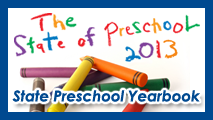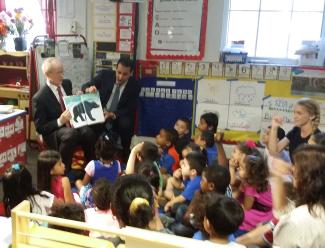
2013 State Preschool Yearbook Finds Need for Renewed Investment
May 13, 2014
Today NIEER released its 2013 State Preschool Yearbookat CentroNía/DC Bilingual Public Charter School in D.C. This newest installment of the Yearbook series covers policies, enrollment, and funding for state-funded pre-K programs in the 2012-2013 school year. Joining NIEER Director Steve Barnett at the event were Myrna Peralta, President/CEO of CentroNía; Roberto Rodriguez of the White House Domestic Policy Council; and Rob Dugger of ReadyNation/America’s Edge

This year’s report found states still struggling to recover from the economic downturn that did so much damage to preschool programs in the previous year. As Barnett noted, “Our nation has emerged from the recession, but preschool-age children are being left to suffer its effects. A year ago, our data showed a half-billion-dollar cut in funding for state pre-K and stalled enrollment. For 2012-2013, we find that enrollment is down and funding per child, while up slightly, remains stalled at near-historic lows.”
Particularly of concern, the report found that:
- In 2012-2013, enrollment decreased by about 9,000 4-year-olds from the prior year across the 40 states plus D.C.[1] that offer pre-K. This is the first enrollment decrease nationally NIEER has observed.
- Slightly more than 1.3 million children attended state-funded pre-K, 1.1 million of them at age 4, accounting for four percent of 3-year-olds and 28 percent of 4-year-olds.
- On the plus side, 20 states increased enrollment while 11 states reduced enrollment.
- One program improved against NIEER’s Quality Standards Benchmarks, while two fell back.
- Also good news, for the first time, every state-funded pre-K program had comprehensive early learning standards. This is first of the quality standards benchmarks to be met by all.
- Four states, plus one of Louisiana’s three programs, met all 10 benchmarks for state pre-K quality standards, the same as in the previous year. This remains down from the peak of five states in 2010-11. Weak program standards persist in too many states, including lax standards for teacher qualifications in 23 programs and no limits on class size and/or teacher child ratio in a few large states–California, Florida and Texas.
- Total state funding for pre-K programs increased by $30 million in real dollars, about a 1 percent increase.
- State pre-K funding per child increased by $36 (inflation-adjusted) from the previous year, to $4,026.
- Only 15 states could be verified as providing enough per-child funding to meet all 10 benchmarks for quality standards. As only 19 percent of the children enrolled in state-funded pre-K attend those programs, it seems likely that most children served by state pre-K attend programs where funding per child is inadequate to provide a quality education.
Dugger, whose organization supports the business case for early childhood education, put the report’s findings in context to America’s economic future. “The most important product the American economy produces are ready-for-life 18-year-olds,” he said. “The US cannot retain organic growth….unless it invests in its children in the early years.”

Rodriguez, of the Domestic Policy Council, highlighted federal/state partnership efforts underway, including $250 million for preschool development grants as well as $500 million to build Early Head Start/Child Care partnerships. He called increased investment in early childhood education “one of the most important things we can do as a country,” and called on governors, mayors, philanthropists, and policymakers to work together to prioritize this investment.
The report covers the most recently completed school year, 2012-2013. Trends may be looking up since then. Many states have recently made pre-K a priority in the time since that school year ended, with new initiatives passing in Connecticut, Maine, and Vermont, just this month and a doubling of state pre-K investment in Alabama over the last two years. New York provides a particular model for state-local collaboration, as leaders at all levels of government came together to prioritize early learning. These stories are a cause for optimism, and action: “If ever there were a time for leaders at the local, state, and national levels to unite in their efforts to provide high-quality preschool education to our next generation, this is it,” Barnett said.
Arne Duncan, U.S. Secretary of Education, called for just such participation on a media call discussing the Yearbook. “We just need Congress to catch up and pay attention to what is happening in the real world,” he said. Duncan added:
“Today, nationally, as the NIEER Yearbook shows, fewer than 30 percent of 4-year-olds are enrolled in state-funded preschool programs, and 10 states still do not offer it at all. Sadly, we’re 25th among industrialized countries in enrollment of 4-year-olds in early learning. If we’re going to lead in the global economy, we must do better – in countries like Germany and Japan, more than 95 percent of 4-year olds are enrolled in early childhood education. Quality early education can be a game-changer for the kids who need the most support. It’s good for them and their families, and for our country’s long-term economic success. Ultimately, it’s an investment in our collective future.”
The full Yearbook report can be found at here, along with state-specific information pages. Join the conversation on Twitter by tweeting @PreschoolToday and using the hashtag #YB2013.
[1] For the sake of comparison, the District of Columbia will be referred to as a “state” throughout this report. Hence, a total of 41 states provide state-funded pre-K.
About NIEER
The National Institute for Early Education Research (NIEER) at the Graduate School of Education, Rutgers University, New Brunswick, NJ, conducts and disseminates independent research and analysis to inform early childhood education policy.
